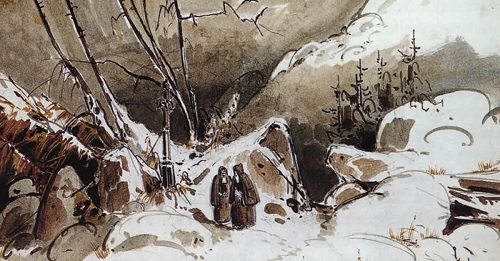In the year 959, Aelfsige, the newly installed Archbishop of Canterbury, was summoned to Rome to receive the pallium from Pope John XII. The pallium—the woolen vestment bestowed by the pope upon a metropolitan bishop—was both a sign of an archbishop’s metropolitan authority, as well as Rome’s recognition of the bishop’s worthiness to the see. It was a liturgical vestment that symbolized the bond between the pope and the metropolitans of the Church.
Since at least the 10th century, with few exceptions the popes had required English bishops of Canterbury to make a special journey to Rome upon their installation to receive the pallium personally from the hands of the pope. So Aelfsige’s journey to Rome in 959 was nothing out of the ordinary. The visit did, however, afford the pope an occasion to inquire into the life and education of these metropolitans, ensuring that they were suitable for their calling. In the case of Aelfsige, there was considerable gossip about the validity of his election. Aelfsige had previously been Bishop of Winchester before being translated to the See of Canterbury. Such a translation was highly irregular, given the Church’s ancient tradition that bishops could not be transferred between sees. Furthermore, England was rife with rumor that Aelfsige had obtained his election by simony. His journey to Rome would have given John XII opportunity to conduct his own investigation into the irregularities of Aelfsige’s elevation.
Unfortunately for Aelfsige, he never made it to Rome. Writing a generation later, a priestly chronicler in the Life of St. Dunstan explained how Aelfsige froze to death in the Alps when en route:
When he strove, according to the custom of the supreme pontiffs, to hasten to the Romulan city for the princely festoon of the pallium, a very great hardship opposed him in the Alpine mountains because of snow. It had immobilized him with such great numbness of cold that he expired, dying under these circumstances. (1)
This event must have made a considerable impression on contemporaries, as it was mentioned in three different hagiographies of the period. Aelfsige’s death certainly highlights the danger of medieval travel, but more so, exemplifies why the English episcopate complained so vehemently about the obligation laid on them by the papacy to journey to Rome in person for palliation.

For medieval chroniclers, Aelfsige’s death settled the question of his worthiness to assume the see of Canterbury. In a time where trial by ordeal was still considered a legitimate manner of determining guilt, the tragedy of Aelfsige’s death offered confirmation that the accusations against his character were true. The three hagiographies that mention the death of Aelfsige all remark on his alleged simoniacal acquisition of the see; two authors depict his freezing to death as an act of divine vengeance for his faults. (2)
By contrast, when St. Dunstan made the trip successfully the following year, his safe arrival was considered a sign of divine favor:
Soon after he had received the episcopate, [Dunstan] made the long march to the Roman city, which is customary for high priests, by a successful route. And the Lord was the companion of his journey and did not abandon the one who held on to Him with pure faith…Finally, with the Lord leading, he reached the desired church of the Roman see, where he gloriously received the princely pallium with the privilege of the prelacy, together with the apostolic blessing. (3)
Since Dunstan’s journey followed only a year after Aelfsige’s demise, we may presume the hagiographer’s comment “the Lord was the companion of his on the journey and did not abandon the one who held on to Him” is meant to contrast the worthiness of Dunstan, who was not abandoned, with the unworthiness of Aelfsige, who was abandoned.
Of course, nobody but God alone knows the guilt of Aelfsige. May he, and all who likewise perished alone and cried out to God in their desperation, rest in peace.
(1) Quoted in Steven A. Schoenig, SJ, Bonds of Wool: The Pallium and Papal Power in the Middle Ages (Catholic University of America: Washington D.C., 2016), 243
(2) Ibid., 287
(3) Ibid., 244
Phillip Campbell, “Archbishop Aelfsige Dies in the Alps,” Unam Sanctam Catholicam, July 3, 2022. Available online at: www.unamsanctamcatholicam.com/archbishop-aelfsige-dies-in-the-alps

